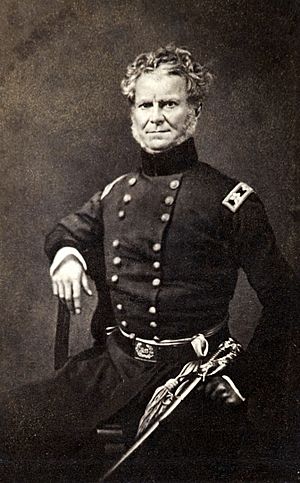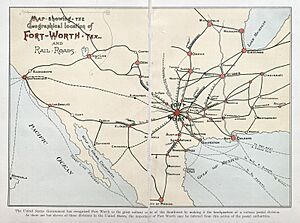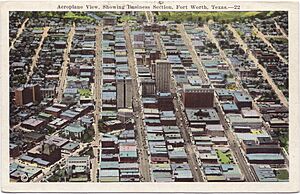History of Fort Worth, Texas facts for kids

The story of Fort Worth, Texas is a big part of the history of northern Texas and the American frontier. It started as a small army outpost to protect settlers from Native American tribes. Later, it became a busy town for cattle ranchers. Today, it's a modern city with many businesses. Even with all these changes, Fort Worth still keeps a lot of its old traditions and history alive.
Contents
Early Days of Fort Worth
The Treaty That Started It All
In 1843, an important agreement called the Treaty of Bird's Fort was signed. This treaty was between the Republic of Texas and several Native American tribes. It said that no one could cross into the Native American territory without permission. Later, "trading houses" were set up where the Clear Fork and West Fork of the Trinity River meet. This is the exact spot where Fort Worth was built!
The U.S. Army built Fort Worth in 1849. It was the most northern fort in a chain of forts. These forts were meant to protect the American Frontier after the Mexican–American War. That's why Fort Worth is still known as "where the West begins."
Building the Fort
In January 1849, William Jenkins Worth, a U.S. Army General, suggested building ten forts. These forts would protect the west Texas frontier. They would stretch from Eagle Pass to the Trinity River. Sadly, General Worth died in May 1849.
General William S. Harney took over. He told Major Ripley A. Arnold to find a good spot for a new fort. On June 6, 1849, Major Arnold set up a camp by the Trinity River. He named it Camp Worth, honoring the late General Worth. In August 1849, the camp moved to a bluff overlooking the Clear Fork. On November 14, 1849, the U.S. War Department officially named it "Fort Worth."
How the Town Grew
Even though Native Americans were trying to protect their land, many pioneers quickly settled near the fort. George "Press" Farmer opened the first store. Other early settlers included Howard W. Peak and Ephraim M. Daggett.
The U.S. Army left Fort Worth on September 17, 1853, because new forts were built further west. But the settlers decided to stay! John Peter Smith started a school in 1854. Archibald Leonard and Henry Daggett opened the first department stores. Julian Feild opened a flour mill and a general store in 1856. Fort Worth also became a stop for important mail and stagecoach lines like the Butterfield Overland Mail.
In 1855, there was a disagreement about where the county government should be. It had been in Birdville since 1849. But Fort Worth citizens wanted it! After a big debate, Fort Worth became the county seat in 1860. A stone courthouse was started, but the Civil War delayed it. It was finished in the 1870s.
Fort Worth faced tough times during the Civil War and the years after. The city's population dropped to only about 175 people. There were shortages of food, supplies, and money. But as the war ended, things slowly got better. By the 1870s, new stores opened, and banks like the Fort Worth National Bank were started. Newspapers like the Fort Worth Chief also began. Schools reopened, helping the town grow again.
The cattle industry was very important for Fort Worth's growth. Cowboys driving cattle to Abilene, Kansas, found Fort Worth a good place to rest. Many cattle buyers came to Fort Worth, leading to new businesses. In 1873, Fort Worth officially became a city, and W. P. Burts was elected its first mayor.
The Panther City Nickname
In 1875, a newspaper article joked about Fort Worth. It said the city was so quiet that a panther was seen sleeping in the street! This was meant to be an insult, but the people of Fort Worth loved it. They embraced the nickname "Panther City."
In 1876, the Texas and Pacific Railway arrived in Fort Worth. This brought a huge boom! The Fort Worth Stockyards became a major center for the cattle industry. The railroad helped the city grow quickly, bringing many new people. Fort Worth became known as the "Queen City of the Prairies." It supplied goods to a large area because of its great transportation links.
Fort Worth in the 20th Century
New Businesses and Oil
In 1902, big meat packing companies like Swift and Armour opened factories in Fort Worth. This created thousands of jobs and made the town much richer. The population tripled, growing from 26,600 to over 73,000 people! Many people moved from farms to the city, and immigrants also arrived. The Fort Worth Gas Company started in 1909, providing gas to nearly 4,000 homes.
A man named W.K. Gordon believed there was oil near Ranger, about 90 miles from Fort Worth. In October 1917, after much effort, he found a huge oil deposit! This turned Ranger into a boom town. Oil was also found in other nearby towns like Desdemona and Breckenridge. Fort Worth was perfectly located between these oil towns, which boosted its economy. Even before the oil boom, Fort Worth had three oil refineries. By 1920, many more were built.
Fort Worth During World War I
In 1917, the Canadian government built three airfields near Fort Worth. When the United States joined World War I, the U.S. military took them over. Camp Bowie was also built in 1917. It was a huge army camp with over 1,500 buildings. Named after Jim Bowie, it trained soldiers for the war. After the war, it helped soldiers return to civilian life before closing in 1919.
Between the Wars
In 1916, Lake Worth (Texas) was finished. It cost $1 million to build and held a lot of water. Some smart business people noticed that people loved going to the beach. So, they built a boardwalk, a bathhouse, rides, and a ballroom. This fun place became known as Casino Park.
In 1918, a new nine-mile long street was built through the Arlington Heights area. It was later renamed Camp Bowie Boulevard in 1919. This was to honor the soldiers who trained in Fort Worth for World War I. Over 700 trees were planted along the street, making Fort Worth even more beautiful.
In 1919, Norton Hinckley and David Tandy started the Hinckley-Tandy Leather Company. They made leather parts for shoes. During World War II, shoe rationing almost closed the business. But Charles D. Tandy changed it into a leather craft company. It grew and later bought RadioShack, an electronics store. Tandy Corporation became RadioShack Corporation in 2000.
In 1936, the Casa Mañana was built by Amon G. Carter, who started the Fort Worth Star-Telegram. It was an outdoor theater with the world's largest rotating stage! It showed Wild West shows and musicals. However, it was expensive to run, and people's attention turned to the upcoming wars. The original building was later taken apart to use its materials for the war effort. A smaller Casa Mañana was rebuilt in 1958. It is now one of Fort Worth's famous landmarks.
Fort Worth During World War II
In 1941, the U.S. Army opened the Fort Worth Army Airfield. It was a school for training pilots to fly heavy bombers. In 1948, it was renamed Carswell Air Force Base.



